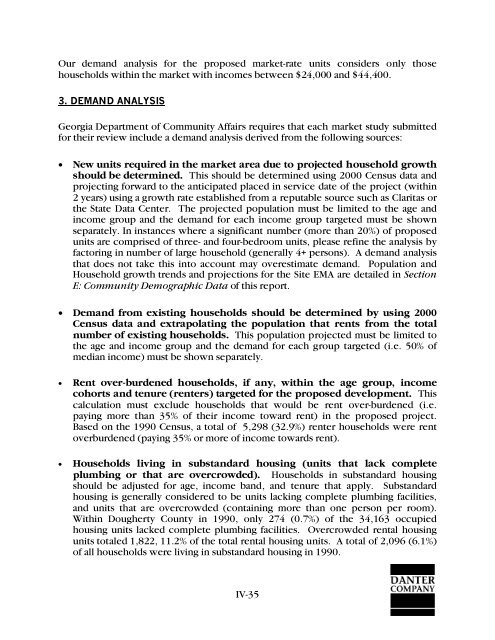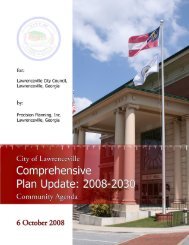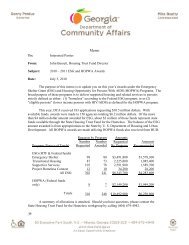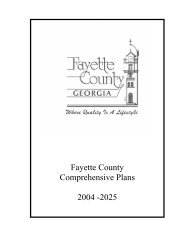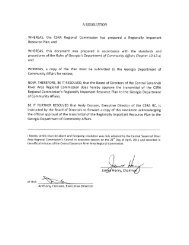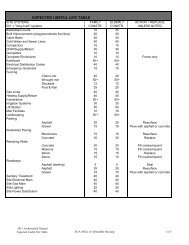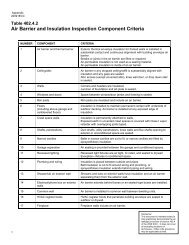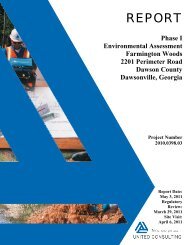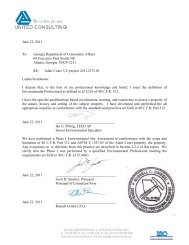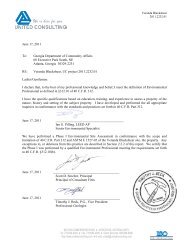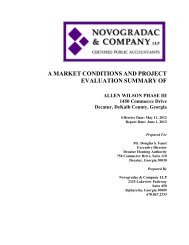14490 full.pdf - Georgia Department of Community Affairs
14490 full.pdf - Georgia Department of Community Affairs
14490 full.pdf - Georgia Department of Community Affairs
You also want an ePaper? Increase the reach of your titles
YUMPU automatically turns print PDFs into web optimized ePapers that Google loves.
Our demand analysis for the proposed market-rate units considers only those<br />
households within the market with incomes between $24,000 and $44,400.<br />
3. DEMAND ANALYSIS<br />
<strong>Georgia</strong> <strong>Department</strong> <strong>of</strong> <strong>Community</strong> <strong>Affairs</strong> requires that each market study submitted<br />
for their review include a demand analysis derived from the following sources:<br />
• New units required in the market area due to projected household growth<br />
should be determined. This should be determined using 2000 Census data and<br />
projecting forward to the anticipated placed in service date <strong>of</strong> the project (within<br />
2 years) using a growth rate established from a reputable source such as Claritas or<br />
the State Data Center. The projected population must be limited to the age and<br />
income group and the demand for each income group targeted must be shown<br />
separately. In instances where a significant number (more than 20%) <strong>of</strong> proposed<br />
units are comprised <strong>of</strong> three- and four-bedroom units, please refine the analysis by<br />
factoring in number <strong>of</strong> large household (generally 4+ persons). A demand analysis<br />
that does not take this into account may overestimate demand. Population and<br />
Household growth trends and projections for the Site EMA are detailed in Section<br />
E: <strong>Community</strong> Demographic Data <strong>of</strong> this report.<br />
• Demand from existing households should be determined by using 2000<br />
Census data and extrapolating the population that rents from the total<br />
number <strong>of</strong> existing households. This population projected must be limited to<br />
the age and income group and the demand for each group targeted (i.e. 50% <strong>of</strong><br />
median income) must be shown separately.<br />
• Rent over-burdened households, if any, within the age group, income<br />
cohorts and tenure (renters) targeted for the proposed development. This<br />
calculation must exclude households that would be rent over-burdened (i.e.<br />
paying more than 35% <strong>of</strong> their income toward rent) in the proposed project.<br />
Based on the 1990 Census, a total <strong>of</strong> 5,298 (32.9%) renter households were rent<br />
overburdened (paying 35% or more <strong>of</strong> income towards rent).<br />
• Households living in substandard housing (units that lack complete<br />
plumbing or that are overcrowded). Households in substandard housing<br />
should be adjusted for age, income band, and tenure that apply. Substandard<br />
housing is generally considered to be units lacking complete plumbing facilities,<br />
and units that are overcrowded (containing more than one person per room).<br />
Within Dougherty County in 1990, only 274 (0.7%) <strong>of</strong> the 34,163 occupied<br />
housing units lacked complete plumbing facilities. Overcrowded rental housing<br />
units totaled 1,822, 11.2% <strong>of</strong> the total rental housing units. A total <strong>of</strong> 2,096 (6.1%)<br />
<strong>of</strong> all households were living in substandard housing in 1990.<br />
IV-35


